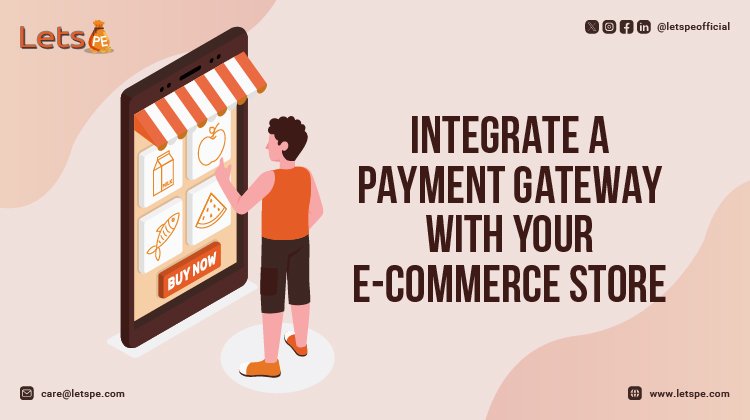How to Integrate a Payment Gateway with Your E-commerce Store
Integrate a Payment Gateway with Your E-commerce Store. Integrated Payment Gateways are directly linked and integrated with your website. Payment gateway integration. Register your business with PhonePe Payment Gateway and accept payments for Free.

What’s a Payment Gateway?
It is a service provider that provides payment clearance. Generally, it’s a software application connecting a website with the bank, so that the users can pay you right there on the spot without leaving their suite. This type of service can be used by anybody, including eCommerce stores, other service providers that prefer their users to pay online, and even non-profit organisations that collect donations online.
There are many various payment gateways, including LetsPe, Stripe, PayPal and direct MasterCard/Visa payments. All of them have their advantages and liabilities too, and each one takes a particular licence.
How E Commerce payment gateway works & why you need it
Generally, online payment systems can be equated with a point of service that can be successfully used for any kind of payment with the help of your bank card. Its main part, in this case, is to authorize the sale, the only difference being that you don’t have to actually use a physical point of service.
If you have an eCommerce store but still wonder whether you need to apply for a payment gateway. You'll need to apply this so that you have the opportunity to gain payments directly from your guests. Indeed, if you also have a brick-and-mortar shop, it still makes sense to add a payment gateway to your website in order to drive more guests and increase deals by serving those who would now be suitable to make it to your physical position. All payments that are reused online are done with no card present, which means that you don't get to see the customer’s card, only the information your client enters in the suggested fields. Without the physical presence of the card, it becomes a bit simpler to commit fraudulent conduct on both ends. This means that the online payment system you use should be dependable and provide a high level of security.
All payment systems use roughly the same mechanisms, conforming to several stages, the majority of which are hidden behind the stage. There's a bunch of communication between different installations, a series of blessings, complex processes of transferring finances, etc. The whole process, in brief, looks like this:
- Confirm your order and enter your payment card details.
- Information security through encryption.
- Information being sent to credit card associations: Visa, Rupay, MasterCard, etc.
- Acceptance or rejection of a transaction.
- The transaction becomes authorized if it is approved.
- Approval on the part of the merchant.
- Payment is delivered to the card issuer.
- Payment is delivered to the appropriate bank.
- The transaction is verified by the bank, and it is added to the cardholder's statement.
Some of these steps happen almost coincidentally, though the funds may take a while to actually appear on your account. Modern gateways ally with all the mentioned operations and authorizations in order to protect both parties and let them finalise their deals. Now you see that the question is not about whether you need a payment system, but it is how to include a payment gateway in a website and how to make sure you chose the right one.
How to choose the right gateway for your eCommerce website

Choosing the right payment gateway for your e-commerce store is a crucial decision as it directly affects your business's capability to utilize payments easily and securely. We are providing you some way to help you while selecting the right payment gateway
Understand Your Business Needs: Assess your business conditions. Consider factors like the type of products or services you provide, your target audience, and the countries or regions you serve.
Consider Supported Payment Methods: Determine which payment method you want to accept. Common options include credit cards, debit cards, digital wallets (e.g., LetsPe Wallet, PayPal), and bank transfers. Choose a payment gateway that supports the payment method your clients prefer.
Evaluate Geographic Coverage: Ensure the payment gateway serves the regions where your clients are located. Some gateways are only available in precise countries or regions.
Fees and Costs: Compare the fee structures of different payment gateways. Consider factors like sale drafts, yearly drafts, setup drafts, and any fresh costs. Pay attention to how these drafts align with your budget and deal volume.
Security and Compliance: Security is proficient. Choose a payment gateway that complies with tenacity security standards (e.g., PCI DSS) and offers strong fraud prohibiting features. Make sure client payment data is handled securely.
Integration with Your E-commerce Platform: If you are using an e-commerce platform (e.g., Shopify, WooCommerce), check for pre-built integrations with payment gateways. This can simplify the integration process and insure comity.

Developer-Friendly: Consider your specialized coffers. Some gateways bear extended development work, while others offer easy- to- apply results. Choose one that matches your specific capabilities.
Customer Experience: Look for a payment gateway that provides a smooth and user-friendly checkout experience. A complicated or heavy payment process can lead to failing abandonment.
Scalability: Suppose about the future. Choose a payment gateway that can calculate your business as it grows. Ensure it can handle increased sales volumes without evolutions.
Customer Support and Reliability: Assess the position of client support provided by the gateway. In case of specialized issues or questions, responsive client support can be valuable. Also, check the gateway's uptime and trustability record.

Reviews and Recommendations: Read reviews and seek recommendations from other e-commerce businesses. Perceptivity from gentlemen can give precious information about the user experience and trustability of different gateways.
Data and Reporting: Consider the position of data and reporting provided by the payment gateway. Perceptivity into sales data can help you make logical business opinions.
Read in Detail - How To Integrate A Payment Gateway Into A Website
Once you've completely estimated these factors, you should have a clearer picture of which payment gateway connects stylishly with your e-commerce store's requirements and claims. Make sure to keep an eye on your gateway's performance and be open to making changes if necessary to improve your clients payment experience.
How to Integrate payment gateway in E commerce store

Integrating a payment gateway into your e-commerce store is a crucial step in enabling online deals. Here's a step-by-step guide to help you with the process:
Choose a Payment Gateway: Inspection and select a payment gateway provider that supports your country and currency. Popular options include LetsPe, Paytm, PayU, and others.
Set Up an Account: Create an account with the chosen payment gateway provider. This may involve presenting business details, bank account information, and possibly supporting your identity.
Access API Documentation: The payment gateway provider will offer API documentation that explains how to integrate their service into your website. This will include information on API endpoints, request/ response formats, and authentication methods.
Integrate the Payment Gateway - Depending on your specialized skills and the platform you are using for your e-commerce store, the integration process can diverge
For Custom-built Websites: If you have a custom-built website, you will need a developer to integrate the payment gateway using the provided APIs.
For E-commerce Platforms (e.g., Shopify, WooCommerce, Magento): These platforms frequently have pre-built integrations for popular payment gateways.
You will generally need to
- Log in to your e-commerce platform's admin panel.
- Navigate to the payment settings.
- Add the necessary stuff (e.g., API keys, trafficker ID) provided by the payment gateway.
Secure and Checkout Process: Attach security measures similar as SSL credentials to cipher data during deals. Also, consider obediently with Payment Card Industry Data Security Standard( PCI DSS) conditions.
Go Live: Once you've completely tested the payment gateway integration, turn it to live mode. This means that real deals will now be utilized.
Handle Errors Gracefully: Set up an error running to give clear dispatches to clients in case of sales failures or errors.
Compliance and Security: Make sure you are gentle with all applicable laws and regulations regarding online payments, especially regarding client data protection.
Customer Support and Documentation: Give clear instructions for clients on how to make payments on your point. Be ready to provide support in case they face any difficulties.
Best Online E-commerce Payment Gateway

LetsPe is the most popular payment gateway and became a household name. One of the most broadly recognized in mobile payments is LetsPe's interface and platform is easy to use and has a renown for being a secure and safe payment gateway. LetsPe Payment Gateway also makes it easy to set up an ecommerce store or accept payments for services concentrated. They have a suite of tools to choose from, so you can customize your shopping cart with ease.
Fraud protection security features are one of the top reasons that make LetsPe a popular payment gateway. Small businesses and large-scale corporations are mostly used LetsPe as there are key benefits of using this payment gateway such as
- Accepts credit card payments e.g. Visa, Mastercard, and many more
- Wide range of payment options e.g. mobile payments, in-person payments, wallets payments and UPI also
- No additional fees on payment
- Instant amount settlement
Conclusion :-
Among all these payment gateway service providers, LetsPe Payment Gateway is the perfect gateway for e-commerce websites or businesses. With LetsPe you can match your customers requirements and provide a better payment experience and achieve new heights.












